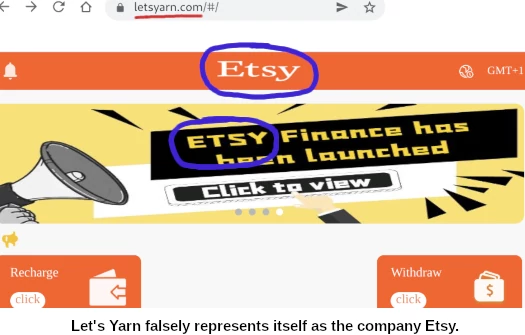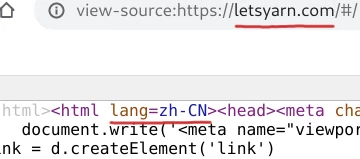Let’s Yarn provides no credible information on its website about who owns or runs the company.
In place of actual company ownership information, Let’s Yarn provides corporate information for Etsy. This information is copied from Etsy’s Wikipedia entry.
Let’s Yarn’s website domain (“letsyarn.com”), was first registered in 2019.
The registration was last updated with bogus details on March 15th, 2022. I believe this is when the current owner(s) took possession of the domain.
if we take a look at Let’s Yarn’s website source-code, we can see localization is set to Chinese:
This strongly suggests whoever is running Let’s Yarn has ties to China.
SimilarWeb ranks top sources of traffic to Let’s Yarn’s website as Switzerland (75%), Russia (6%) and Belarus (5%).
As always, if an MLM company is not openly upfront about who is running or owns it, think long and hard about joining and/or handing over any money.
Let’s Yarn’s Products
Let’s Yarn has no retailable products or services.
Affiliates are only able to market Let’s Yarn affiliate membership itself.
Let’s Yarn’s Compensation Plan
Let’s Yarn affiliates invest tether on the promise of daily returns.
To qualify for daily returns, Let’s Yarn affiliates must log in to the company’s app and click a button. The more a Let’s Earn affiliate invests, the more times they need to click the button each day.
Recruitment is also required for larger investment amounts:
- invest 1 to 499 USDT and receive 0.26 USDT per button clicked (max 50 button clicks a day)
- invest 500 to 1999.99 USDT and receive 0.28 UDST per button clicked (max 55 button clicks a day), must also recruit five affiliates
- invest 2000 to 4999.99 USDT and receive 0.30 USDT per button clicked (max 60 button clicks a day), must also recruit ten affiliates
- invest 5000 to 9999.99 USDT and receive 0.32 USDT per button clicked (max 70 button clicks a day), must also recruit eighteen affiliates
The MLM side of Let’s Yarn pays on recruitment of affiliate investors.
Referral Commissions
Let’s Yarn pays referral commissions on USDT invested by affiliates.
Referral commissions are paid down three levels of recruitment (unilevel):
- level 1 (personally recruited affiliates) – 16%
- level 2 – 8%
- level 3 – 4%
New User Bonus
The New User Bonus rewards affiliates with an additional percentage on personal recruitment:
- recruit an affiliate who invests 30 USDT and receive 1.88 USDT
- recruit an affiliate who invests 100 USDT and receive 3.88 USDT
- recruit an affiliate who invests 500 USDT and receive 8.88 USDT
- recruit an affiliate who invests 2000 USDT and receive 38.88 USDT
- recruit an affiliate who invests 10,000 USDT and receive 188.88 USDT
Joining Let’s Yarn
Let’s Yarn affiliate membership is free.
Full particpation in the attached income opportunity requires investment in tether.
Let’s Yarn Conclusion
Whereas we’ve seen “click a button” app Ponzis represent they have partnerships with legitimate companies, Let’s Yarn falsely represents it is Etsy.
I don’t think I need to explain why that’s nonsensical.
The “click a button” ruse behind Let’s Yarn’s Ponzi is clicking a button generates Etsy orders. And this somehow translates into revenue to pay returns with.
This is of course baloney. All Let’s Yarn are doing is recycling invested funds to pay returns.
Let’s Yarn is part of a group of “click a button” app Ponzis launched over the past few months.
Thus far BehindMLM has documented:
- COTP – pretended affiliates clicking a button generated trading activity, collapsed May 2022
- EthTRX is a similar app-based Ponzi, with the daily task component disabled
- Yu Klik – pretends clicking a button generates trading activity, targeting Indonesia
- KKBT – pretended clicking a button generates crypto mining revenue, targeted South Africa and India & collapsed early June 2022
- EasyTask 888 – pretends clicking a button was tied to social media manipulation (YouTube likes), targets Colombia
- DF Finance – pretended clicking a button generated “purchase data” which was sold to ecommerce platforms, collapsed June 2022
- Shared989 – pretended clicking a button was tied to social media manipulation (YouTube likes etc.), collapsed June 2022
- 86FB – pretended clicking a button was tied to gambling on football match outcomes, collapsed April 2022
- 0W886 – pretended clicking a button was tied to gambling on football match outcomes, collapsed May 2022
- U91 – pretended clicking a button was tied to gambling on football match outcomes, collapsed May 2022
- 365Ball – pretends clicking a button is tied to gambling on football match outcomes, (has collapsed multiple already)
- YLCH Football – pretends clicking a button is tied to gambling on football match outcomes
- Parkour – pretends clicking a button is tied to social media manipulation (YouTube likes etc.)
- OTCAI – pretended affiliates clicking a button generated trading activity, collapsed May 2022
- N9 Football – pretended affiliates clicking a button was tied to gambling on football match outcomes, collapsed May 2022
- Tron.BI – pretends affiliates clicking a button was tied to TRX cloud mining
- EFG Football – pretended affiliates clicking a button was tied to gambling on football match outcomes, collapsed May 2022
- GP Football – pretended affiliates clicking a button was tied to gambling on football match outcomes, collapsed May 2022
- Lucky Football, pretended affiliates clicking a button was tied to gambling on football match outcomes, collapsed May 2022
- WT91 – pretends affiliates clicking a button is tied to gambling on football match outcomes
- Mars Football – pretends affiliates clicking a button is tied to gambling on football match outcomes
- MC Football – pretends affiliates clicking a button is tied to gambling on football match outcomes
- PerRank – pretended affiliates clicking a button generated orders for ecommerce partners, collapsed June 2022
- Zpmxcfe – pretends clicking a button is tied to social media manipulation (YouTube likes etc.)
All the recent app-based task Ponzis appear to be launched by the same group of scammers.
Based on the use of simplified Chinese, I suspect the group are operating out of China or Singapore.


